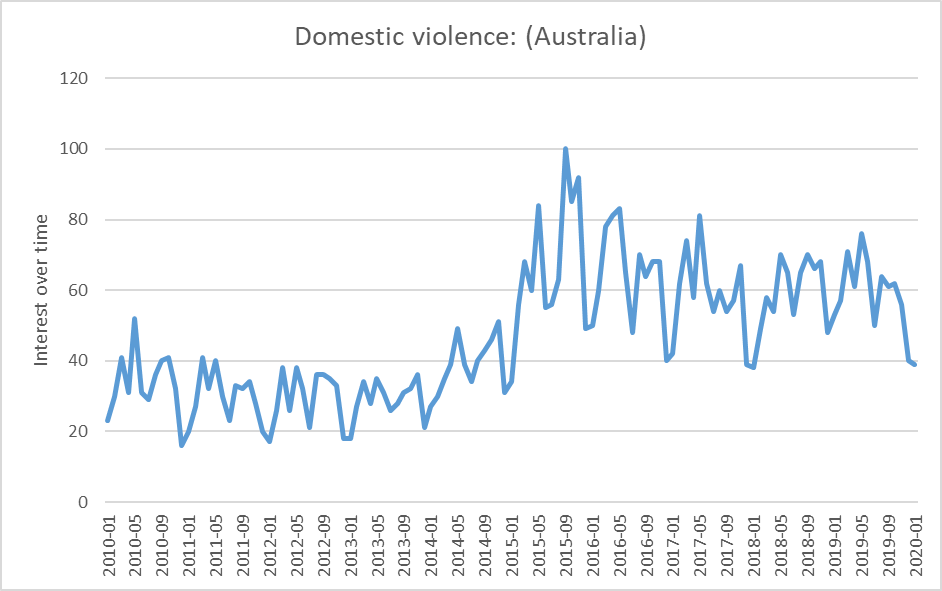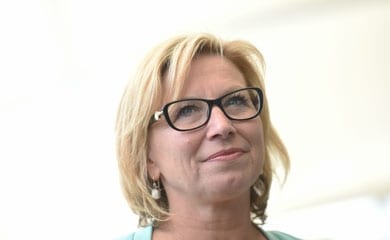“If anything comes out of this, I want it to be a lesson to everybody that family violence happens to everybody no matter how nice your house is, no matter how intelligent you are, it happens to anyone and everyone.”
These simple words and the grief-stricken image of Rosie Batty speaking to media outside her home the morning after her 11-year-old son Luke was murdered by his father at cricket training are etched into the memories of many Australians. While some realised at the time that these words and the woman who spoke them were remarkable, few could have foreseen that they would signal the beginning of an extraordinary period of social and political transformation across Australia.
Domestic and family violence is a widespread problem globally
Domestic and family violence (DFV) is widespread and results in significant personal, government, and business costs. In Australia, intimate partner violence is the highest health risk factor (greater than smoking, alcohol, and obesity) for women in their reproductive years (18-44 years).
Yet, until Luke’s tragic death in 2014, the subsequent outpouring of community grief, and the commencement of Rosie’s advocacy, DFV was an issue that was rarely publicly discussed. It was a private issue, kept behind closed doors. Something then Chief Commissioner of Victoria Police, Ken Lay, described as “Australia’s filthy little secret.”

From 2015 things started to change
As Figure 1 indicates, an increase in website searches for the term domestic violence peaked in 2015 when Rosie was named Australian of the Year and began a period of extensive and relentless advocacy. DFV became an issue of public, media, and political concern. And it became an issue that people demanded could and should be addressed and prevented.
Research undertaken as part of my PhD at Monash University, and published in Violence Against Women, examines the role Rosie played in helping bring about this period of remarkable change and considers other socio-political factors that provided the conditions for change.
Together with my Monash University co-authors, Professor Jacqui True, Associate Professor Asher Flynn, and Abby Wild, I sought to understand what it was about Rosie and what it was about that moment in history that made this transformation possible. Ultimately, we wanted to know how we might maintain this sort of momentum and bring about real, lasting improvements in policies and services to support victim-survivors of DFV.
Our research consisted of an in-depth interview with Rosie and interviews with eight policy actors. Interview data were supplemented by analyses of media and government reports and other documents. We found that Rosie possesses personal characteristics and capabilities, which in many ways made her the ‘ideal victim’ and policy entrepreneur/change agent. Her ability to understand others and to put herself in their shoes was particularly notable, as was her driving ambition to ensure that no one else would go through the same sort of tragedy she had.
One of the most important themes to emerge from the interviews was the importance of Rosie’s outsider status and the fact she was not from the DFV sector or government. We found that in responding to wicked policy problems like DFV, it is increasingly common for individual actors who are very often outside government to be the ones bringing about reform. Rosie’s outsider status, together with the power and urgency of her lived experience, enabled her to overcome institutional divisions and ideological differences to build networks encompassing the expertise and institutional know-how required to achieve substantial change.
A window of opportunity
We also found that Rosie’s advocacy began at a time when a ‘window of opportunity’ had opened up in Victoria, following the election of the Andrews’ Labor Government, which had made an election commitment to hold a Royal Commission into family violence. Several interviews also provided a clear sense that the Andrews’ Government saw DFV as the issue that would offer the opportunity to break down silos and undertake the business of government differently. Rosie provided the community support and momentum for this change.
The feminist movement
The foundations established by decades of work done by the feminist movement and organisations, such as the Victorian Health Promotion Foundation (VicHealth), also emerged as an illuminating theme in our research. For example, VicHealth’s Preventing violence before it occurs framework was identified as key in explaining the gendered drivers of violence against women and identifying actions to address those determinants. This groundwork provided a framework for understanding DFV. It meant that within pockets of the State Government and the DFV and public health sectors, there was a workforce ready to make the most of the opportunities Rosie and the new government presented.
Risks and limitations
However, our study also found risks and limitations associated with engaging victim-survivors in reform efforts. In looking at the history of the victims’ rights movement, we discovered that victim-survivors have invariably been used to promote political agendas in a way that rarely helps them. Our research confirmed that gendered power imbalances, stereotypes, and social norms, particularly regarding ‘ideal victims,’ mean many victim-survivors can feel pressure to be compliant and avoid upsetting powerful interests. We also found the assumption, made by some policy actors, that Rosie’s experience would open the door for other, more diverse victim-survivors was wrong.
Despite the prioritisation of victim-survivors voices, there are still many less “ideal,” more representative voices that are not being heard. Initiatives engaging victim-survivors in the development of public policy must address these power imbalances. Ensuring the empowerment and autonomy of victim-survivors is critical.
The public component of the Commonwealth Government’s National Summit on Women’s Safety is commencing today, and is described as “the cornerstone of consultation activities” to inform the development of the successor plan to the National Plan to Reduce Violence against Women and their Children. Sadly, none of the sessions currently on the program focus on victim-survivor advocates. An Australia-wide collective of domestic, family and sexual violence abuse and violence victim-survivors and survivor advocates has written to relevant Commonwealth, State and Territory Ministers, including Senator the Hon Anne Ruston Minister for Women’s Safety (Cth), to voice their dismay with this oversight.
It is critical that the next National Plan is informed and driven by the lived experiences of victim-survivors, and by those who have been failed by the very systems which were meant to support them, such as the Family Court.
Engagement with victim-survivors must also be ongoing. It should be built into each initiative under the National Plan. Governments must also be careful to prioritise voices that are often marginalised, and to ensure the autonomy and independence of those voices.
Writer Ursula K. le Guin said, “When we women offer our experience as our truth, as human truth, all the maps change. There are new mountains.” Rosie spoke her truth that morning in February 2014, and she has continued to speak her truth throughout her advocacy. Speaking truth to power shines a light on system failures and can bring about positive change. We just need those in power to be brave enough to listen.


